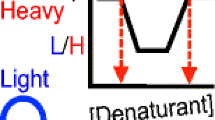Abstract
Detection and quantitation of protein–ligand binding interactions is important in many areas of biological research. Stability of proteins from rates of oxidation (SPROX) is an energetics-based technique for identifying the proteins targets of ligands in complex biological mixtures. Knowing the false-positive rate of protein target discovery in proteome-wide SPROX experiments is important for the correct interpretation of results. Reported here are the results of a control SPROX experiment in which chemical denaturation data is obtained on the proteins in two samples that originated from the same yeast lysate, as would be done in a typical SPROX experiment except that one sample would be spiked with the test ligand. False-positive rates of 1.2-2.2 % and <0.8 % are calculated for SPROX experiments using Q-TOF and Orbitrap mass spectrometer systems, respectively. Our results indicate that the false-positive rate is largely determined by random errors associated with the mass spectral analysis of the isobaric mass tag (e.g., iTRAQ®) reporter ions used for peptide quantitation. Our results also suggest that technical replicates can be used to effectively eliminate such false positives that result from this random error, as is demonstrated in a SPROX experiment to identify yeast protein targets of the drug, manassantin A. The impact of ion purity in the tandem mass spectral analyses and of background oxidation on the false-positive rate of protein target discovery using SPROX is also discussed.

ᅟ





Similar content being viewed by others
References
Jelesarov, I., Bosshard, H.R.: Isothermal titration calorimetry and differential scanning calorimetry as complementary tools to investigate the energetics of biomolecular recognition. J. Mol. Recognit. 12, 3–18 (1999)
Oshannessy, D.J., Brighamburke, M., Soneson, K.K., Hensley, P., Brooks, I.: Determination of rate and equilibrium binding constants for macromolecular interactions using surface-plasmon resonance—use of nonlinear least-squares analysis-methods. Anal. Biochem. 212, 457–468 (1993)
Fields, S., Song, O.K.: A novel genetic system to detect protein–protein interactions. Nature 340, 245–246 (1989)
Fashena, S.J., Serebriiskii, I., Golemis, E.A.: The continued evolution of two-hybrid screening approaches in yeast: how to outwit different preys with different baits. Gene 250, 1–14 (2000)
SenGupta, D.J., Zhang, B.L., Kraemer, B., Pochart, P., Fields, S., Wickens, M.: A three-hybrid system to detect RNA–protein interactions in vivo. Proc. Natl. Acad. Sci. U.S.A. 93, 8496–8501 (1996)
Templin, M.F., Stoll, D., Schrenk, M., Traub, P.C., Vohringer, C.F., Joos, T.O.: Protein microarray technology. Trends Biotechnol. 20, 160–166 (2002)
Ghaemmaghami, S., Fitzgerald, M.C., Oas, T.G.: A quantitative, high-throughput screen for protein stability. Proc. Natl. Acad. Sci. U.S.A. 97, 8296–8301 (2000)
Ghaemmaghami, S., Oas, T.G.: Quantitative protein stability measurement in vivo. Nat. Struct. Biol. 8, 879–882 (2001)
Siburt, C.J.P., Roulhac, P.L., Weaver, K.D., Noto, J.M., Mietzner, T.A., Cornelissen, C.N., Fitzgerald, M.C., Crumbliss, A.L.: Hijacking transferrin bound iron: protein–receptor interactions involved in iron transport in N-gonorrhoeae. Metallomics 1, 249–255 (2009)
West, G.M., Tang, L., Fitzgerald, M.C.: Thermodynamic analysis of protein stability and ligand binding using a chemical modification- and mass-spectrometry based strategy. Anal. Chem. 80, 4175–4185 (2008)
West, G.M., Tucker, C.L., Xu, T., Park, S.K., Han, X.M., Yates, J.R., Fitzgerald, M.C.: Quantitative proteomics approach for identifying protein–drug interactions in complex mixtures using protein stability measurements. Proc. Natl. Acad. Sci. U.S.A. 107, 9078–9082 (2010)
Strickland, E.C., Geer, M.A., Tran, D.T., Adhikari, J., West, G.M., DeArmond, P.D., Xu, Y., Fitzgerald, M.C.: Thermodynamic analysis of protein–ligand binding interactions in complex biological mixtures using the stability of proteins from rates of oxidation. Nat. Protoc. 8, 148–161 (2013)
DeArmond, P.D., Xu, Y., Strickland, E.C., Daniels, K.G., Fitzgerald, M.C.: Thermodynamic analysis of protein–ligand interactions in complex biological mixtures using a shotgun proteomics approach. J. Prot. Res. 10, 4948–4958 (2011)
DeArmond, P.D., West, G.M., Huang, H.T., Fitzgerald, M.C.: Stable isotope labeling strategy for protein–ligand binding analysis in multi-component protein mixtures. J. Am. Soc. Mass Spectrom. 22, 418–430 (2011)
Liu, P.F., Kihara, D., Park, C.: Energetics-based discovery of protein–ligand interactions on a proteomic scale. J. Mol. Biol. 408, 147–162 (2011)
Chang, Y., Schlebach, J.P., VerHeul, R.A., Park, C.: Simplified proteomics approach to discover protein–ligand interactions. Protein Sci. 21, 1280–1287 (2012)
Park, C.W., Marqusee, S.: Pulse proteolysis: a simple method for quantitative determination of protein stability and ligand binding. Nat. Methods 2, 207–212 (2005)
Kim, H., Kasper, A.C., Moon, E.J., Park, Y., Wooten, C.M., Dewhirst, M.W., Hong, J.Y.: Nucleophilic addition of organozinc reagents to 2-sulfonyl cyclic ethers: stereoselective synthesis of manassantins A and B. Org. Lett. 11, 89–92 (2009)
Hossain, C.F., Kim, Y.P., Baerson, S.R., Zhang, L., Bruick, R.K., Mohammed, K.A., Agarwal, A.K., Nagle, D.G., Zhou, Y.D.: Saururus cernuus lignans—potent small molecule inhibitors of hypoxia-inducible factor-1. Biochem. Biophys. Res. Commun. 333, 1026–1033 (2005)
Kasper, A.C., Moon, E.J., Hu, X.Q., Park, Y., Wooten, C.M., Kim, H., Yang, W.T., Dewhirst, M.W., Hong, J.Y.: Analysis of HIF-1 inhibition by manassantin A and analogues with modified tetrahydrofuran configurations. Bioorg. Med. Chem. Lett. 19, 3783–3786 (2009)
Christoforou, A.L., Lilley, K.S.: Isobaric tagging approaches in quantitative proteomics: the ups and downs. Anal. Bioanal. Chem. 404, 1029–1037 (2012)
Morand, K., Talbo, G., Mann, M.: Oxidation of peptides during electrospray-ionization. Rapid Commun. Mass Spectrom. 7, 738–743 (1993)
Acknowledgments
The authors acknowledge support for this work by a grant from the National Institutes of Health (GM084174) to M.C.F. and by a Research Scholar Grant (122057-RSG-12-045-01-CDD) from the American Cancer Society to J.H. The authors also thank Lisa Jones and the Proteomics Facility at the Fred Hutchinson Cancer Center for the collection of Orbitrap data.
Author information
Authors and Affiliations
Corresponding author
Electronic supplementary material
Below is the link to the electronic supplementary material.
ESM 1
(DOCX 110 kb)
Rights and permissions
About this article
Cite this article
Strickland, E.C., Geer, M.A., Hong, J. et al. False-Positive Rate Determination of Protein Target Discovery using a Covalent Modification- and Mass Spectrometry-Based Proteomics Platform. J. Am. Soc. Mass Spectrom. 25, 132–140 (2014). https://doi.org/10.1007/s13361-013-0754-2
Received:
Revised:
Accepted:
Published:
Issue Date:
DOI: https://doi.org/10.1007/s13361-013-0754-2




